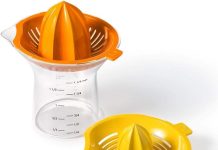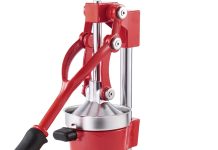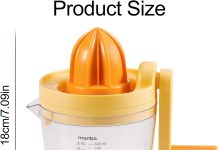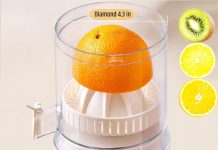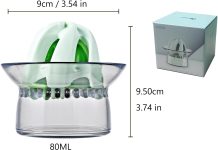Ladies and gentlemen, today we aim to settle one of the most pressing debates in the world of juicing: is it better to juice in a blender or a juicer?
We all know that juicing has become wildly popular for its myriad health benefits, but the question of which machine yields the best results has left many enthusiasts scratching their heads.
In this article, we will explore the pros and cons of both options, allowing you to make an informed decision and sip on your favorite homemade concoctions confidently. Stick around as we break it down, one juice at a time!
Review contents
Health Benefits
Nutrient Retention
When it comes to juicing, one of the biggest concerns is to retain the maximum amount of nutrients from the fruits and vegetables. Both blenders and juicers have their advantages in this regard.
Blenders utilize a high-speed rotation to blend the entire produce, including the skin and fibrous parts. This process helps retain the fiber content of the fruits and vegetables, ensuring that you receive all the beneficial nutrients.
On the other hand, Juicers extract the juice by separating the pulp from the juice. This allows for easier absorption of nutrients by the body as the pulp is removed. However, certain nutrients present in the pulp, such as dietary fiber, may be lost in the process.
Fiber Content
Fiber is an essential component of a healthy diet, as it aids in digestion and helps to regulate blood sugar levels. Blending fruits and vegetables in a blender produces thicker and more fiber-rich juice than juicers. The fiber content in blended juice can help you feel fuller for longer, reducing cravings and promoting a healthy digestive system.
On the other hand, Juicers extract the juice from the produce, leaving behind the fiber as pulp. While this may result in a lower fiber content juice, it allows for a smoother and easier digestion process, making it ideal for individuals with sensitive digestive systems.
Easy Digestion
One of the advantages of using a juicer is that the juice extracted is more accessible to digest than blended juice. Juicing removes the insoluble fiber in the produce, which can sometimes be difficult for specific individuals to digest.
However, blending the produce in a blender retains the fiber content, which aids in digestion and promotes a healthy digestive system. The fiber is a natural cleanser for the digestive tract, improving bowel movements and overall gut health.
Quality of Juice
Smoothness
Regarding the texture of the juice, blenders tend to produce thicker and more smooth juice than juicers. The high-speed blending process in a blender breaks the produce into a fine consistency, resulting in a satisfyingly smooth drink.
On the other hand, juicers tend to produce a thinner and less smooth juice due to the separation of the pulp. While some juicers are designed to produce smooth juice, there may still be a slight texture due to removing the pulp.
Consistency
The consistency of the juice can vary depending on the type of appliance used. Blenders tend to produce a more consistent juice in terms of thickness and texture. The fibers from the produce are thoroughly blended, resulting in a uniform consistency throughout the juice.
Juicers, on the other hand, can produce juices with varying consistencies. Some juicers have settings that allow you to adjust the amount of pulp in the juice, giving you control over the consistency. However, certain juicers may produce a juice that is slightly thinner or thicker depending on the type of produce used.
Separation
One of the common concerns with juicers is the separation of the juice. Juicers often extract the juice from the pulp, resulting in a separation of the two components. This can lead to the juice separating into layers, with the lighter juice on top and the denser pulp settling at the bottom.
Blenders, on the other hand, blend the produce into a homogeneous mixture, eliminating the issue of separation. This ensures you receive a well-mixed and consistent juice without any layers forming.
Pulp Content
The amount of pulp in the juice can vary depending on the appliance used. Blenders retain more pulp in the juice, producing a thicker and more substantial drink. This can be beneficial for individuals looking to increase their fiber intake.
On the other hand, Juicers remove the pulp from the juice, resulting in a smoother and pulp-free drink. This can be preferred by those who prefer a lighter and easier-to-digest juice.
Efficiency and Speed
Preparation Time
When it comes to preparation time, blenders and juicers have their pros and cons. Blenders generally require more preparation time as the produce needs to be chopped into smaller pieces before blending. This can be time-consuming, especially when dealing with a large amount of produce.
On the other hand, Juicers require less preparation time as they can handle whole fruits and vegetables. This eliminates the need for chopping, saving you time and effort in the preparation process.
Juicing Process
In terms of the juicing process itself, blenders tend to be slower compared to juicers. Blending the produce takes time, especially if you want to achieve a smooth consistency. This can be a drawback if you seek a quick and efficient juicing process.
On the other hand, Juicers are designed explicitly for juicing, making the process faster and more efficient. Most juicers have potent motors and specialized mechanisms that extract the juice quickly and effectively.
Cleaning
Cleaning is an important aspect to consider when choosing between a blender and a juicer. Blenders are relatively easier to clean compared to juicers. After blending, rinse the blender pitcher and blades with water and detergent. However, some blenders may have hard-to-reach areas that require extra attention during cleaning.
On the other hand, Juicers require more thorough cleaning due to the separation of pulp and juice. The juicing components of the juicer, such as the pulp collection container and the juice outlet, need to be disassembled and cleaned separately. This can be time-consuming, especially if the juicer has many small parts.
Juice Yield
Extraction Efficiency
Juice yield refers to the amount of juice extracted from the produce. In terms of extraction efficiency, juicers are generally more efficient than blenders. Juicers are specifically designed to extract the maximum amount of juice from fruits and vegetables, leaving behind the dry pulp.
Blenders, on the other hand, may not be as efficient in extracting juice from the produce. The high-speed blending process can trap some juice in the fibers and pulp, resulting in a lower yield.
Pulp Dryness
The dryness of the pulp is an indicator of the extraction efficiency of the appliance. With their specialized mechanisms, Juicers can extract juice efficiently, resulting in a drier pulp. This indicates that the juicer has extracted most of the juice from the produce.
Conversely, Blenders may not be able to extract as much juice as juicers, resulting in a wetter pulp. While some blenders may have features to minimize the amount of moisture in the pulp, they may not be as efficient as juicers.
Versatility
Recipe Diversity
When it comes to recipe diversity, blenders offer a more comprehensive range of options compared to juicers. Blenders can be used to create juices, smoothies, soups, sauces, and even nut butter. The versatility of blenders allows you to experiment with different ingredients and flavors, making it a versatile kitchen appliance.
Juicers, on the other hand, are mainly used for juicing fruits and vegetables. While some juicers may have additional features to make nut milk or sorbets, they primarily extract juice. This limits the variety of recipes that can be made with a juicer.
Food Processing
Blenders excel in food processing tasks thanks to their powerful motors and sharp blades. You can use a blender to puree fruits and vegetables, crush ice, grind seeds or nuts, and even make dough for baking. The ability to perform multiple food processing tasks makes blenders a versatile tool in the kitchen.
Juicers, on the other hand, are primarily designed for juicing. While some juicers may have limited food processing capabilities, such as grinding coffee beans or making frozen desserts, they are not as versatile as blenders.
Cost
Initial Investment
The cost is essential when choosing between a blender and a juicer. Regarding initial investment, blenders tend to be more affordable than juicers. Blenders come in a wide range of prices, from budget-friendly options to high-end models with advanced features.
On the other hand, Juicers can be more expensive, especially if you opt for a high-quality juicer with advanced functionalities. The price of juicers can vary depending on the type and brand, with centrifugal juicers generally being more affordable than masticating juicers.
Long-Term Expense
While blenders may be more affordable initially, the long-term expense should also be considered. Because blenders blend the entire produce, including the fiber-rich parts, you may need more fruits and vegetables to achieve a satisfying amount of juice. This can increase your long-term expenses, especially if you juice frequently.
On the other hand, Juicers extract the juice from the produce, resulting in a concentrated juice that requires fewer fruits and vegetables. This can be more cost-effective in the long run as you can extract more juice from less produce.
Noise Level
Blender
Noise level is essential, especially if you live in a shared living space or have a noise-sensitive household. Blenders tend to be louder than juicers, especially when blending tough or fibrous produce. The high-speed rotation of the blades can generate significant noise, which may disturb others in the vicinity.
Juicer
On the other hand, Juicers tend to be quieter than blenders. Most juicers operate at a lower speed, making less noise during juicing. However, certain types of juicers, such as centrifugal juicers, may still produce moderate noise due to their high-speed motors.
Ease of Use
Operation
Both blenders and juicers are relatively easy to use, with straightforward controls and settings. Blenders generally have a few speed settings that allow you to adjust the blending intensity and duration. Some blenders even have pre-programmed settings for specific tasks, such as smoothies or soups, making them user-friendly.
Juicers have a straightforward operation, with basic controls for starting and stopping the juicing process. However, certain juicers may have additional settings for adjusting the amount of pulp in the juice or for juicing different types of produce.
Assembly and Disassembly
The assembly and disassembly process can vary between blenders and juicers. Blenders usually have a simple design that allows for easy assembly and disassembly. After use, you can easily remove the blender pitcher or attachment and clean the parts separately.
On the other hand, Juicers may have more components that need to be assembled and disassembled. This can be slightly more time-consuming, especially if the juicer has many small parts that must be cleaned thoroughly.
Portability
Size
The size of the appliance can play a role in its portability. Blenders come in various sizes, from compact personal blenders to large countertop models. This allows for more flexibility in terms of portability, as you can choose a blender that suits your needs and kitchen space.
Juicers, on the other hand, can be bulkier compared to blenders. The juicing components, such as the pulp collection container and juice outlet, can take up more space on the countertop or in storage. However, some juicers may be compact, allowing easy storage and transport.
Weight
Blenders are generally lighter compared to juicers. This makes them more portable and accessible, especially if you need to store them in a cabinet or take them on trips or vacations.
On the other hand, Juicers can be heavier due to the additional components and mechanisms. This can make them less portable, especially if you need to transport them frequently.
Preference and Taste
Texture
The texture of the juice can vary depending on the appliance used. Blenders tend to produce juice with a thicker texture due to the retention of fiber and pulp. This can be desirable for individuals who enjoy a more substantial and filling juice.
On the other hand, Juicers tend to produce juice with a smoother texture due to the removal of pulp. This can be preferred by individuals who prefer a lighter and more refreshing juice.
Flavor
Both blenders and juicers retain the natural flavors of the fruits and vegetables. The blending or juicing process helps to extract the flavors and aromas from the produce, resulting in a refreshing and flavorful juice.
However, some individuals may find that blended juice has a stronger and more pronounced flavor than juiced juice. This is because blended juice’s fiber and pulp contribute to the flavor profile, making it more intense.
Enjoyment
The enjoyment of juicing can vary depending on personal preferences. Some individuals may enjoy the process of blending and experimenting with different ingredients in a blender. Blenders allow for more creativity and variety in recipes and flavors, making it a fun experience.
Others may prefer the simplicity and convenience of juicers. Juicers provide a quick and efficient way to extract juice from fruits and vegetables, making it ideal for individuals with a busy lifestyle or those who prefer a fuss-free juicing experience.
In conclusion, choosing between a blender and a juicer depends on your preferences, needs, and priorities.
Blenders are versatile for recipe diversity, high nutrient retention, and easy cleaning. On the other hand, juicers excel in extraction efficiency, delivering smoother juice with easier digestion. Consider the factors discussed in this article to make an informed decision that suits your lifestyle and health goals.



